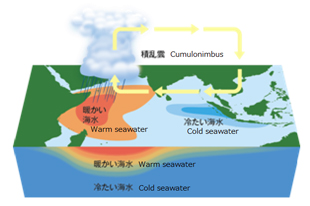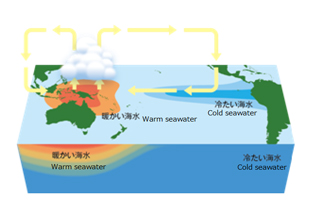Press Releases
July 10, 2014
JAMSTEC
Role of Climate Variability in Heatstroke in Kanto Region Identified
1.Overview
A joint research team of Application Laboratory, Japan Agency for Marine-Earth Science and Technology (JAMSTEC: Asahiko Taira, President) and Mr. Akihiko Takaya (ex-researcher at Graduate School of Frontier Sciences, the Tokyo University) analyzed 30 years of statistical data (*1) and weather observational data (*2) during boreal summer of 1980-2010, aiming to understand the role of climate variability in the heatstroke death toll.
The result demonstrated that death toll by heatstroke is highly correlated with extremely hot days on which the temperature exceed 35 degrees Celsius and also the number of such hot days are related to El Niño-Southern Oscillation(*3) or the Indian Ocean Dipole(*4). It suggests a possible link between tropical climate variability and heatstroke. Precise prediction of climate variability using climate models is, therefore, expected to contribute to preventing heatstroke patients by alerting the general public to possible extremely hot days in advance.
These research results have been published in the Nature Publishing Group’s online scientific journal Scientific Reports on July 10, 2014 (Japan time 18:00).
Title: Role of climate variability in the heatstroke death rates of Kanto region in Japan
Authors:Akihiko Takaya, Yushi Morioka1, Swadhin K. Behera1
1. JAMSTEC Application Laboratory
*1 Statistical data: Vital statistics provided by Ministry of Health, Labor and Welfare
*2 Weather observational data: AMeDAS Ver. 3 provided by Japan Meteorological Business Support Center
*3 El Niño-Southern Oscillation: A naturally occurring phenomenon that involves fluctuating ocean temperatures in the equatorial Pacific. The sea surface temperatures in the central and eastern tropical Pacific Ocean become higher than normal during El Niño, while they become lower than normal during La Niña events. In Japan, El Niño events tend to bring cold summer and warm winter and La Niña extreme summer heat and sever winter.
*4 Indian Ocean dipole mode (IOD): A coupled ocean-atmosphere phenomenon in the Indian Ocean. A positive IOD phase is characterized by cooler than normal water in the tropical eastern Indian Ocean and warmer than normal water in the tropical western Indian Ocean. In contrast, a negative IOD phase is characterized by warmer than normal water in the tropical eastern Indian Ocean and cooler than normal water in the tropical western Indian Ocean. The positive IOD phase tends to bring extremely hot summer in Japan.
[Reference]Tropical climate phenomena affecting summertime Japan climate

Positive IOD phase

La Niña

Figure 1: Time series of the death toll by heatstroke (bar, in persons) and the WBGT (Wet Bulb Globe Temperature) index (solid line, in deg C) during boreal summer (July–August) of 1980–2010.

Figure 2: Time series of the number of extremely hot days (bar, in days) and its anomaly (solid line, in days) averaged in the Kanto region during boreal summer (July–August) of 1980–2010.

Figure 3: (a) Time series of the NINO3.4 index (solid line, in deg C) during boreal summer (July–August) of 1980–2010. The broken line indicates the standard deviation. (b) Same as in (a), but for the IOD index (solid line, in deg C).
Contacts:
- (For this study)
- Yushi Morioka, Application Laboratory
- (For press release)
- Kazushige Kikuchi, Manager, Press Division, Public Relations Department